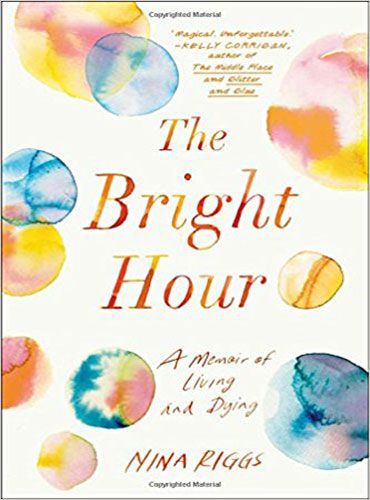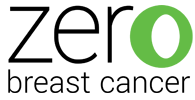The Bright Hour by Nina Riggs

Overview
In her book, published posthumously, the great-great-great granddaughter of Ralph Waldo Emerson deals with not one, not two, but three serious health issues simultaneously impacting her life; her own aggressive metastatic breast cancer at 38 years of age, her mother’s final stages of, and death from multiple myeloma (cancer) and her nearly 8 year old son’s diagnosis of (likely familial) type 1 diabetes.
Each one of these alone would have been enough to be disruptive. The author challenges herself to name the unnamable and face reality unflinchingly. Allowing herself some degree of sentimentality and sadness in expressing her emotional and psychological terrors she never becomes remotely close to self-pity or whining.
Oh - and simultaneously one of her closest friends (similar age) is diagnosed with the same form of aggressive hard to treat breast cancer and who predeceases the author by several months.
Even though the book is a memoir and a work of non-fiction, the experience of reading it is akin to reading fine prose in parts. The writing is all at once lyrical, precise, clear and pithy. A self-confessed ‘google addict’ the author has not written a book about, or synthesis of, everything one might want to know about her disease or those of her mother or son. Reading this book feels more like reading a personal journal and being inside both the head and the heart of the author experiencing her ‘normal life’ as a mother, daughter, wife, friend and women as it intersects with, and is increasingly dominated by, her metastatic cancer and the treatments she must undergo. Through a series of ‘flashbacks’ we learn much about her personal - and some family – history, her inner life, her relationships and the great the loves of her life – husband John and young sons Freddy and Benny.
We get to know Nina Briggs the whole person, as she integrates all her fears and pain into her experience and processed them in her own unique way. Despite a disease that ultimately proves overwhelming and terminal for her mother and then for her, a robust spirit of humanity, resilience and humility shines through. This is a book that should be so incredibly hard to read and yet is not. Strange to say but it is even beautiful to read – empathizing with the author is both a moving and a very intimate experience.
How the book is organized
The book begins with a short Prologue and is then organized into four sections that the author calls Stages. Although not explicitly stated, it is likely no coincidence that the approach echoes the medical language used to describe how her cancer becomes more entrenched and spreads throughout her body. Each Stage in the book contains a varying number of chapters. These chapters are more akin to daily musings or journal entries so we will break with our usual approach to these reviews and provide a brief cliff note to each Stage rather than to each and every chapter as there are close to 100 of them! The book concludes with an Afterword and Acknowledgments. There is no chapter listing, no index and no references. This is a very personal autobiography.
Prologue
We meet the author and her nuclear family and get a glimpse of how serious her triple negative breast cancer is.
Stage One
This first part of the book consists of 22 chapters, many of them quite short. Each chapter is either a) a vignette that draws the reader into the author’s family and her day-to-day life or a b) a meditation on the various experiences of her breast cancer from diagnosis through initial chemo treatment. The tone of this section is mostly dispassionate – out of body observations of reactions and interactions to the process of diagnosis, initial chemotherapy and consideration of surgery options.
All the while life continues around her in all its ups, downs and overall messiness as her husband John holds the center together calmly and stoically. He has no real inkling that this is not just some short lived blip that will pass relatively quickly. At this point in time the author’s concerns for the health of her mother and her son loom larger than her own illness. The author’s doctors are very upbeat about her prognosis and she trusts them wholeheartedly.
Stage Two
These 23 chapters cover the period of surgery (a single mastectomy of the diseased breast) and the aftermath of comprehending the implications for body image and sense of femininity. The author and her husband must factor in this new reality into their relationship and sex life. It seems that the tumors are not responsive to standard chemotherapy and the seriousness of the situation starts to become apparent as more aggressive chemo and radiation is prescribed.
The author starts to contemplate the challenge of helping two young boys understand that their Mom has a serious disease in age appropriate ways. It is notable that although the author and her husband seek expert advice and support they bring their own authentic honesty to the conversations with their children. They don’t sugar coat any of it nor leave the children with any kind of false hopes but shower them with love and keep life as normal as possible for them while imparting information in a matter of fact way.
During this stage the author’s mother’s impending death looms and the way this unfolds creates a powerful example of how to face death in an orderly, pragmatic and fearless way. Or as Nina Riggs puts it – her mother was “fearless of being afraid”.
Stage Three
The briefest of the four stages time wise -and the shortest at just 20 chapters – begins with the author’s mother being cared for at home by hospice services and her death shortly thereafter.
The twist so to speak is that the author is vastly more aware of her own mortality than most people are when they lose a parent in the ‘natural order of things’. She leans into death and dying as she starts to explore her own mortality in ways not normative for someone of her age and stage in contemporary America.
For much of this Stage we follow the author through a predictable arc of comprehending and processing the practical aspects of the funeral arrangements – in this case cremations - and two services – while the finality and permanence of her loss starts to sink in. The author’s gift as a writer is to bring the reader into the process of bereavement, of mourning and of memories in a way that doesn’t feel like an invasion of privacy.
Simultaneously the author is also back in chemotherapy and the drugs being used are the big guns – the ones that are very toxic and do a lot of collateral damage to healthy cells in the process of containing the cancer. Radiation is also prescribed and her oncologist steers her away from moving forward with breast reconstruction to avoid complications from infections while she is still in active treatment. While less certain about a good outcome than before the oncologist maintains an optimistic approach.
All this without her beloved mother’s support and companionship anymore.
Stage Four
This Stage begins with a return to the aftermath of an incident first recounted in the Prologue: The Bike Ride when the author trips and falls while teaching her younger son to ride a bike. Tests expose the fact that her back has broken as a result of the cancer metastasizing into her bones even as she is still being actively treated for what her doctors considered localized, containable breast cancer.
It’s the longest section of the book at 32 chapters and explores all the interactions, emotions and thoughts that come up for the author as she starts to comprehend that she now has stage four terminal breast cancer and her mortality is something that cannot be escaped from nor denied. She explores both the most mundane and most profound implications as this realization deepens; she confronts the implications for her as a mother (the hardest of all), a wife and a member of an extended family, friend group and community. She is too young to die at barely 40. Her boys will not even be teens when she does.
The medical ‘stuff’ is ever present and the author’s physical suffering real but it's somehow just there, in the background. Everyone is doing their best and many aspects suck but there is not one shred of animosity by the author towards the limitations and lack of (current) medical answers or solutions for her.
Afterword
This is written by Nina Riggs’s husband John Duberstein and describes the last day, and hours, before she dies in a hospice facility close to their home at 6 a.m. on February 26th, 2017.
Conclusion and Recommendations
Near the end of the book the author quotes a cousin who lost a spouse to cancer; “living with a terminal disease is like walking on a tightrope over an insanely scary abyss. But that living without disease is also like walking on a tightrope over an insanely scary abyss, only with some fog or cloud obscuring the depths a bit more – sometimes the wind blowing it off a little, sometimes a nice dense cover” (page 243). This resonated strongly for Nina Riggs and this insight and perspective goes a long way to explain why her aggressive metastasize breast cancer never paralyses her, never robs her of her essential life essence or humanity.
Oftentimes the reviews on dust covers of books are generically effusive and somewhat predictable. In this case the reviews are genuinely heartfelt, specific and right on point. “Gorgeous and brave….” Dr. Lucy Kalanithi. “Magical. Unforgettable.” Kelly Corrigan, New York Times bestselling author of The Middle Place and Glitter and Glue. “Profound, absorbing and often even funny…” Gretchen Rubin, New York Times bestselling author of The Happiness Project and Better than Before.
“Nina Riggs writes gorgeously and with astonishing clarity. She never shies away from describing the terrible sadness and messiness of her own dying, but also manages to suffuse this book with a miraculous blend of light and joy. This is an emotional journey told with raw honesty and also a sly sense of humor. The Bright Hour is an instant classic…. A book about dying that has powerful lessons for everyone about how to life.” Will Schwalbe, New York Times bestselling author of The End of Your Life Book Club and Books for Living.
We could not say it better ourselves and highly recommend this book.
This book is 366 pages.
Hard cover and Kindle editions available on Amazon
Book Reviewed by Rose Barlow, ED Zero Breast Cancer.

